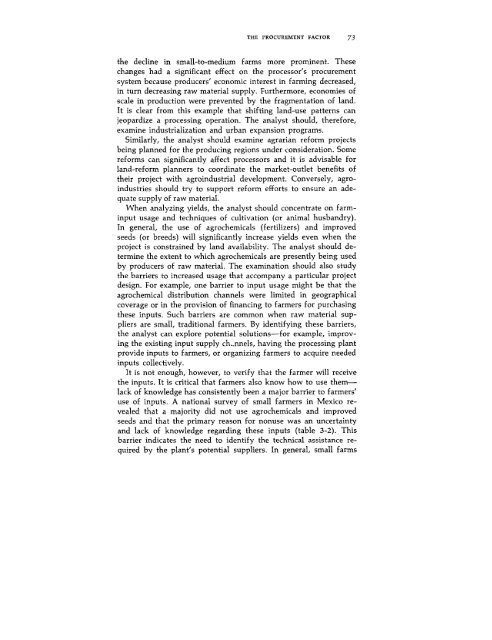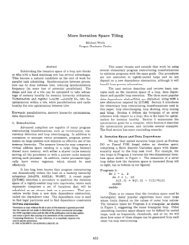Agroindustrial project analysi
Agroindustrial project analysi
Agroindustrial project analysi
- No tags were found...
You also want an ePaper? Increase the reach of your titles
YUMPU automatically turns print PDFs into web optimized ePapers that Google loves.
THE PROCUREMENT FACTOR 73the decline in small-to-medium farms more prominent. Thesechanges had a significant effect on the processor's procurementsystem because producers' economic interest in farming decreased,in turn decreasing raw material supply. Furthermore, economies ofscale in production were prevented by the fragmentation of land.It is clear from this example that shifting land-use patterns canjeopardize a processing operation. The analyst should, therefore,examine industrialization and urban expansion programs.Similarly, the analyst should examine agrarian reform <strong>project</strong>sbeing planned for the producing regions under consideration. Somereforms can significantly affect processors and it is advisable forland-reform planners to coordinate the market-outlet benefits oftheir <strong>project</strong> with agroindustrial development. Conversely, agroindustriesshould try to support reform efforts to ensure an adequatesupply of raw material.When analyzing yields, the analyst should concentrate on farminputusage and techniques of cultivation (or animal husbandry).In general, the use of agrochemicals (fertilizers) and improvedseeds (or breeds) will significantly increase yields even when the<strong>project</strong> is constrained by land availability. The analyst should determinethe extent to which agrochemicals are presently being usedby producers of raw material. The examination should also studythe barriers to increased usage that accompany a particular <strong>project</strong>design. For example, one barrier to input usage might be that theagrochemical distribution channels were limited in geographicalcoverage or in the provision of financing to farmers for purchasingthese inputs. Such barriers are common when raw material suppliersare small, traditional farmers. By identifying these barriers,the analyst can explore potential solutions-for example, improvingthe existing input supply ch..nnels, having the processing plantprovide inputs to farmers, or organizing farmers to acquire neededinputs collectively.It is not enough, however, to verify that the farmer will receivethe inputs. It is critical that farmers also know how to use themlackof knowledge has consistently been a major barrier to farmers'use of inputs. A national survey of small farmers in Mexico revealedthat a majority did not use agrochemicals and improvedseeds and that the primary reason for nonuse was an uncertaintyand lack of knowledge regarding these inputs (table 3-2). Thisbarrier indicates the need to identify the technical assistance requiredby the plant's potential suppliers. In general, small farms













![Problem 1: Loop Unrolling [18 points] In this problem, we will use the ...](https://img.yumpu.com/36629594/1/184x260/problem-1-loop-unrolling-18-points-in-this-problem-we-will-use-the-.jpg?quality=85)


